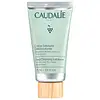What's inside
What's inside
 Key Ingredients
Key Ingredients

 Benefits
Benefits

 Concerns
Concerns

 Ingredients Side-by-side
Ingredients Side-by-side

Water
Skin ConditioningHexyldecyl Stearate
EmollientGlycerin
HumectantPumice
AbrasiveGlyceryl Stearate
EmollientPentaerythrityl Distearate
EmulsifyingArachidyl Alcohol
EmollientVitis Vinifera Fruit Water
Skin ConditioningBehenyl Alcohol
EmollientPolyacrylate Crosspolymer-6
Emulsion StabilisingArachidyl Glucoside
EmulsifyingPotassium Cetyl Phosphate
EmulsifyingHelianthus Annuus Seed Oil
EmollientTocopherol
AntioxidantCaprylyl Glycol
EmollientPotassium Sorbate
PreservativeMenthol
MaskingXanthan Gum
EmulsifyingCitric Acid
BufferingLimonene
PerfumingSodium Phytate
Vitis Vinifera Juice
AntioxidantSodium Benzoate
MaskingParfum
MaskingWater, Hexyldecyl Stearate, Glycerin, Pumice, Glyceryl Stearate, Pentaerythrityl Distearate, Arachidyl Alcohol, Vitis Vinifera Fruit Water, Behenyl Alcohol, Polyacrylate Crosspolymer-6, Arachidyl Glucoside, Potassium Cetyl Phosphate, Helianthus Annuus Seed Oil, Tocopherol, Caprylyl Glycol, Potassium Sorbate, Menthol, Xanthan Gum, Citric Acid, Limonene, Sodium Phytate, Vitis Vinifera Juice, Sodium Benzoate, Parfum
Water
Skin ConditioningCoco-Betaine
CleansingPropanediol
SolventPEG-120 Methyl Glucose Dioleate
EmulsifyingSodium Chloride
MaskingSodium Cocoyl Glycinate
CleansingDipropylene Glycol
HumectantZinc Gluconate
Skin ConditioningSalicylic Acid
MaskingBifida Ferment Lysate
Skin ConditioningSodium Hydroxide
BufferingSodium Benzoate
MaskingPhenoxyethanol
PreservativeCopper Gluconate
Skin ConditioningCaprylyl Glycol
EmollientTetrasodium Glutamate Diacetate
Parfum
MaskingWater, Coco-Betaine, Propanediol, PEG-120 Methyl Glucose Dioleate, Sodium Chloride, Sodium Cocoyl Glycinate, Dipropylene Glycol, Zinc Gluconate, Salicylic Acid, Bifida Ferment Lysate, Sodium Hydroxide, Sodium Benzoate, Phenoxyethanol, Copper Gluconate, Caprylyl Glycol, Tetrasodium Glutamate Diacetate, Parfum
 Reviews
Reviews

Ingredients Explained
These ingredients are found in both products.
Ingredients higher up in an ingredient list are typically present in a larger amount.
Caprylyl Glycol is a humectant and emollient, meaning it attracts and preserves moisture.
It is a common ingredient in many products, especially those designed to hydrate skin. The primary benefits are retaining moisture, skin softening, and promoting a healthy skin barrier.
Though Caprylyl Glycol is an alcohol derived from fatty acids, it is not the kind that can dry out skin.
This ingredient is also used as a preservative to extend the life of products. It has slight antimicrobial properties.
Learn more about Caprylyl GlycolParfum is a catch-all term for an ingredient or more that is used to give a scent to products.
Also called "fragrance", this ingredient can be a blend of hundreds of chemicals or plant oils. This means every product with "fragrance" or "parfum" in the ingredients list is a different mixture.
For instance, Habanolide is a proprietary trade name for a specific aroma chemical. When used as a fragrance ingredient in cosmetics, most aroma chemicals fall under the broad labeling category of “FRAGRANCE” or “PARFUM” according to EU and US regulations.
The term 'parfum' or 'fragrance' is not regulated in many countries. In many cases, it is up to the brand to define this term.
For instance, many brands choose to label themselves as "fragrance-free" because they are not using synthetic fragrances. However, their products may still contain ingredients such as essential oils that are considered a fragrance by INCI standards.
One example is Calendula flower extract. Calendula is an essential oil that still imparts a scent or 'fragrance'.
Depending on the blend, the ingredients in the mixture can cause allergies and sensitivities on the skin. Some ingredients that are known EU allergens include linalool and citronellol.
Parfum can also be used to mask or cover an unpleasant scent.
The bottom line is: not all fragrances/parfum/ingredients are created equally. If you are worried about fragrances, we recommend taking a closer look at an ingredient. And of course, we always recommend speaking with a professional.
Learn more about ParfumSodium Benzoate is a preservative. It's used in both cosmetic and food products to inhibit the growth of mold and bacteria. It is typically produced synthetically.
Both the US FDA and EU Health Committee have approved the use of sodium benzoate. In the US, levels of 0.1% (of the total product) are allowed.
Sodium benzoate works as a preservative by inhibiting the growth of bacteria inside of cells. It prevents the cell from fermenting a type of sugar using an enzyme called phosphofructokinase.
It is the salt of benzoic acid. Foods containing sodium benzoate include soda, salad dressings, condiments, fruit juices, wines, and snack foods.
Studies for using ascorbic acid and sodium benzoate in cosmetics are lacking, especially in skincare routines with multiple steps.
We always recommend speaking with a professional, such as a dermatologist, if you have any concerns.
Learn more about Sodium BenzoateWater. It's the most common cosmetic ingredient of all. You'll usually see it at the top of ingredient lists, meaning that it makes up the largest part of the product.
So why is it so popular? Water most often acts as a solvent - this means that it helps dissolve other ingredients into the formulation.
You'll also recognize water as that liquid we all need to stay alive. If you see this, drink a glass of water. Stay hydrated!
Learn more about Water